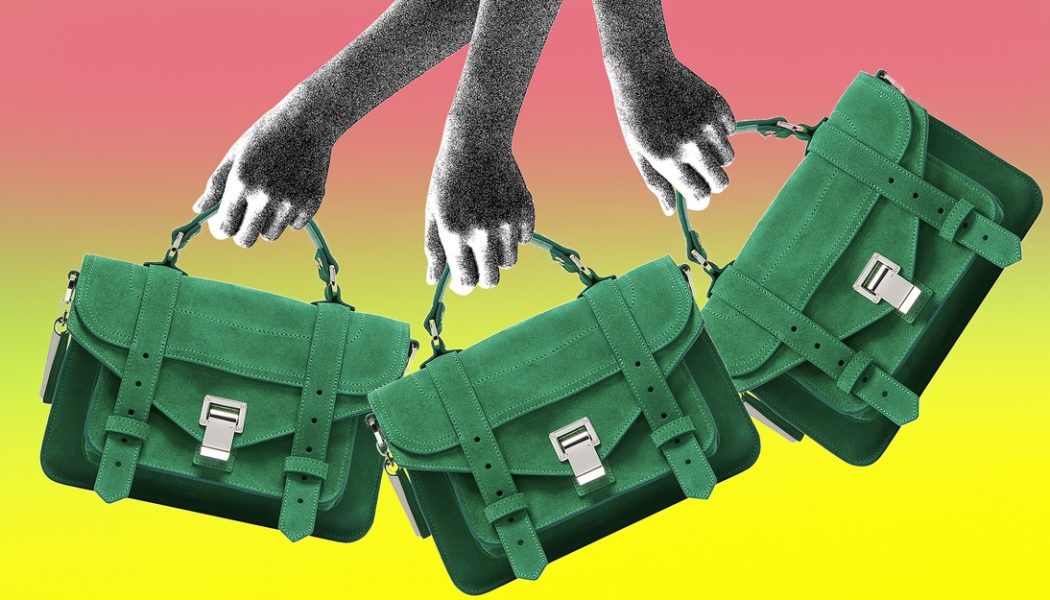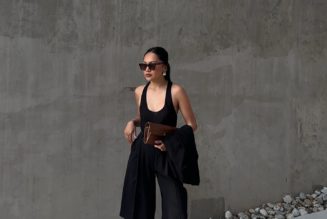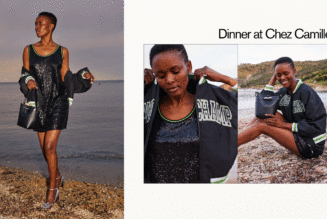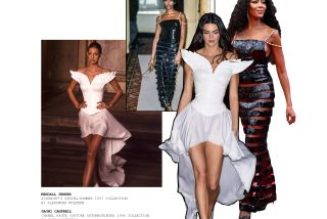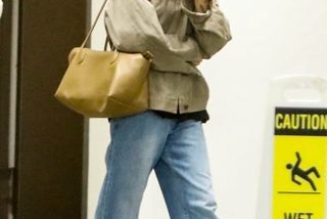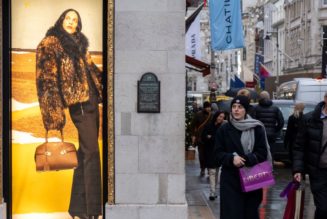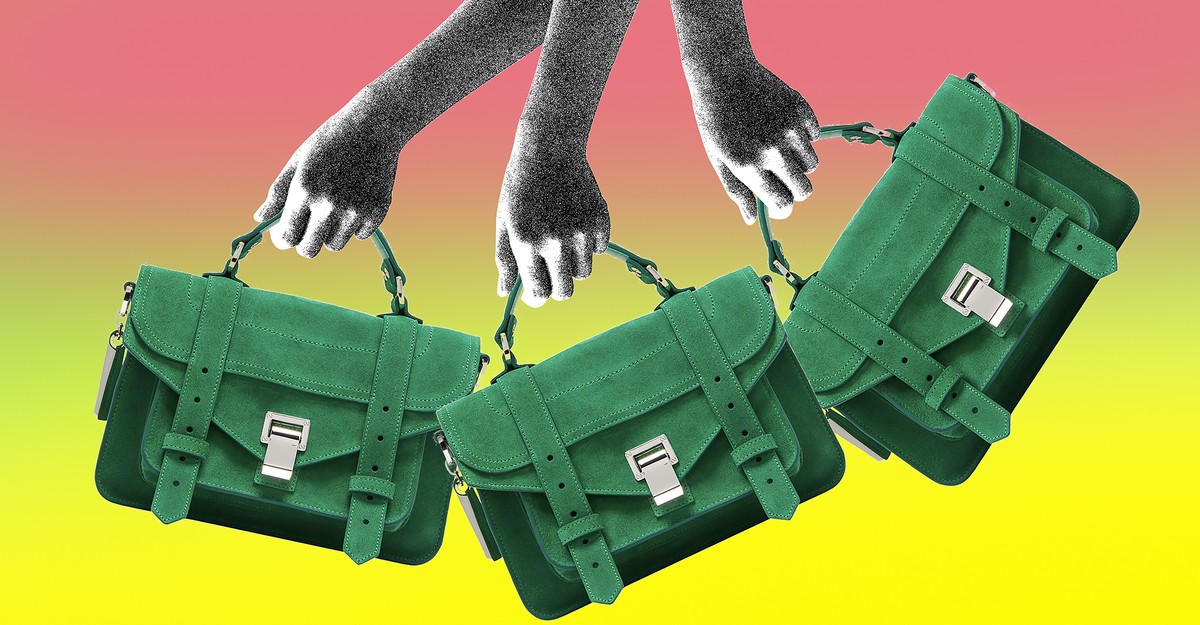
Nearly half a decade has elapsed since I last worked in the fashion industry, but one thing from my previous career remains a compulsion to this day: I look at people’s purses. In the brain space that might otherwise be occupied by dear childhood memories or the dates and times of future doctor appointments, I tend to an apparently undeletable mental spreadsheet of who is carrying what. Bottega Veneta Cassette, green padded leather, Soho, 20-something woman. Louis Vuitton Pochette Métis, logo canvas, Hoyt-Schermerhorn subway stop, 40-ish woman. For 10 years, these data points informed my obsessive, detailed coverage of the luxury-handbag market. Now they just accumulate. Rarely do I see something I can’t place.
Over the past year or two, though, something largely unprecedented has been happening on people’s shoulders. Old bags are back. A significant—and growing—number of fashion-conscious people appear to be mining the depths of their closets or scouring secondhand marketplaces for designs released in the past decade or so. These women aren’t merely hunting down vintage styles of historical fashion significance, or the timeless classics that a wealthy mom might pass down to her daughter. Instead, many of them are carrying precisely the bags that should be at the nadir of popularity: one-off seasonal releases, designs whose trendiness peaked in the 2010s, and other bags that would otherwise scan as outdated to anyone in the know. One of fashion’s most basic rules is that nothing is less cool than the recent past, yet here are trendy people parading around like it’s 2015.
Signs of wear on these bags are no dealbreaker. As The New York Times recently noted, some Hermès Birkin buyers are now looking for older, broken-in bags in order to cultivate a more relaxed vibe. They’re also a (relative) bargain. Data from the secondhand luxury marketplace The RealReal suggest that this trend extends across the handbag market. Demand for like-new versions of recent releases has eased in favor of older, used designs, including those with obvious imperfections. Sales of designer bags in “fair” condition, which can have scuffed corners or other highly visible markers of use, nearly doubled in 2022.
This shift in consumer desire would be easy to dismiss as a whim of the market—we’re talking about the vagaries of fancy handbags, after all, and fashion is a cyclical business that constantly refers to its own history in new products. Within this shift in demand, though, is a signal that something larger may be afoot. Fashion, as an industry, may have started to butt up against the limits of a buying public that it has pushed to exhaustion. What does it mean when people begin to tire of novelty itself?
Handbags have a unique place in the fashion industry because they are so ludicrously marketable. They’re what you might call a trophy purchase: something easily recognizable to people who have even a passing interest in fashion, which enhances their desirability as potent status markers. (Though as one unfortunate Tinder date learned on the most recent episode of Succession, it is entirely possible to spend three grand on a purse and signal precisely the wrong status, depending on your audience.) Bags are also more practical than party dresses or high heels, and they avoid the fit issues of clothing. A $3,000 bag is still impossibly expensive for the average person, but it’s something that many, many more people can (and do) mentally justify putting on their credit card than a similarly expensive sweater. As a result, handbags are among the most important financial engines of the luxury sector, with a growing global market worth tens of billions of dollars annually. For many designer brands—and especially those with wide name recognition outside the industry—bags are the business, no matter how many other kinds of products they might produce.
For years, this has been a splendid state of affairs for luxury brands, but things between brands and buyers have lately become a little tense. The first major problem is that prices have skyrocketed. Designer handbags have always been very expensive—that is sort of their defining feature, if we’re all being honest—but according to a 2022 market analysis by Business of Fashion, the average price for a designer handbag in the United States had increased by 27 percent since 2019. For some of the most highly prized bags, the number is even more outrageous—the Chanel Classic Flap bag, for example, saw a price hike of 60 percent in roughly the same period. Those sudden, sharp hikes come after years of smaller, steadier increases, which had already doubled the price of some bags in the space of about a decade.
The second major problem: Even as prices climb, the handbag market has become oversaturated and its products overexposed. Designers are pushed to produce more frequent and larger product releases—the old industry standard was two collections a year, in spring and fall, and now most big brands produce five or six. And brands have become more risk averse when it comes to new design ideas; bags’ centrality to the businesses’ bottom line means there’s vanishingly little patience for designers who create things that are too forward-thinking to catch on instantaneously.
The way these problems were created is largely a story of consolidation—a phenomenon not unique to the fashion industry. Once upon a time, high-end fashion was the province of family-owned businesses that employed skilled artisans in European workshops, piecing together leather goods according to the old methods. Now most major brands are owned by luxury conglomerates that mass-produce much of their inventory, the biggest and most valuable of which are LVMH and Kering. Those two companies oversee almost all the heavy hitters in the accessories industry: Louis Vuitton, Dior, Gucci, Bottega Veneta, Fendi, Celine, Balenciaga, and Saint Laurent, among others.
When a business becomes a subsidiary of a public company, which LVMH and Kering are, some expectations are predictable. Shareholders want profitability and growth, so designers produce more and take fewer risks. To goose sales figures, there’s nothing quite as quick and dirty as simply raising prices, which can have the benefit of making a bag seem all the more exclusive. Although brands offer various rationales for their increases—fluctuations in currency exchange, higher manufacturing prices, supply issues—in my experience, the most common reason for an increase is the belief that the market will bear it.
So far, this belief has panned out. During the pandemic, well-off people in most global fashion markets saved money by taking a year or two off from travel, dining, and other expensive pursuits, and many of them, bored at home and looking for a little stimulation, used the extra cash to buy things like expensive watches and designer handbags. But as consumer markets have begun to normalize, we now have a fire hose of inescapably common, exorbitantly priced handbags that aren’t particularly singular or compelling. There is an unresolvable tension between being told that the thing you’re buying is expensive because it is rare and special and will last a lifetime, and seeing that thing become near-instantly ubiquitous among celebrities, Instagram influencers, and half the girlies at brunch, just to get ditched wholesale a few months later for something newer and shinier, if only slightly different. This tension has always existed, but social media and online shopping have accelerated the trend cycle so much that one of the industry’s best sleights of hand no longer feels quite so magical. At this point, showing people that it still works on you might even feel a little embarrassing.
It’s no wonder that shoppers are summoning the ghosts of handbags past. For a business predicated on moving people efficiently forward to new ideas and new products, fashion seems content to do little more than play the hits right now. Meanwhile, shoppers at all price levels are in thrall to a years-long retro revival, mining resale platforms and thrift stores for things more unique or whimsical than what’s newly available. Designer bags have been part of that trend, particularly those from the It Bag era of the mid-2000s, when Chloé’s Paddington and Silverado bags inspired long waitlists and the Fendi Baguette bag and Hermès Birkin both got their own story lines on Sex and the City. Many of that period’s designs were genuinely interesting attempts to rethink the category’s aesthetic conventions—in other words, precisely the kinds of designs that big brands now generally decline to create, mortgaging their long-term relevance in a bid for short-term financial returns.
You can tell that this phenomenon is more than just an era-specific trend, because growing interest in older bags extends far beyond that time to similarly distinctive pieces from much of the past 20 years, including bags such as the Proenza Schouler PS1 and PS11, which hit their peak popularity in the mid-2010s—much too recently to be retro. Most of these styles are abundantly available on resale websites for a couple hundred bucks, a far cry from the thousands of dollars that the same designers charge for new pieces.
As shoppers have made older bags popular, brands have looked at this phenomenon and learned the wrong lessons. In the past few years, they’ve reissued many of these old designs in an attempt to capture existing nostalgia, but most of the pieces, which were never affordable to begin with, are now far more expensive. And even if the reissued bags help keep sales up for another quarter or two, they’re not a solution for malaise among buyers, who seem to be growing tired of both gimmicky logo-mania and the same old timeless, neutral classics. More than anything, they might be sick of the relentless pressure to keep buying, and to spend ever more money to do little beyond prove that they still can. For fashion customers, there’s something to be gained from the industry’s creative stalemate, even if it’s just the realization that the things you actually want to wear or carry right now might already be in your closet.
